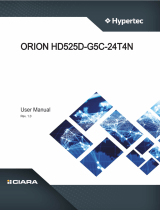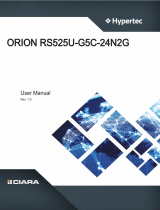
- 8 -
3-12-2 H262-PC2 ...............................................................................................................50
Chapter 4 Motherboard Components ...........................................................................57
4-1 Motherboard Components ............................................................................. 57
4-2 Jumper Setting .............................................................................................. 58
4-3 Backplane Board Storage Connector ............................................................. 59
4-3-1 CBPH7O0 (H262-NO1) ..........................................................................................59
4-3-2 CBPH080 (H262-PC2) ...........................................................................................60
Chapter 5 BIOS Setup ..................................................................................................61
5-1 The Main Menu .............................................................................................. 63
5-2 Advanced Menu ............................................................................................. 66
5-2-1 Trusted Computing .................................................................................................67
5-2-2 Serial Port Console Redirection .............................................................................68
5-2-3 SIO Conguration ...................................................................................................72
5-2-4 PCI Subsystem Settings .........................................................................................73
5-2-5 USB Conguration ..................................................................................................74
5-2-6 Network Stack Conguration ..................................................................................75
5-2-7 Post Report Conguration ......................................................................................76
5-2-8 NVMe Conguration ...............................................................................................77
5-2-9 Chipset Conguration .............................................................................................78
5-2-10 Tls Auth Conguration ............................................................................................79
5-2-11 iSCSI Conguration ................................................................................................80
5-3 Chipset Menu ................................................................................................. 81
5-3-1 Processor Conguration .........................................................................................82
5-3-2 Common RefCode Conguration ...........................................................................85
5-3-3 UPI Conguration ...................................................................................................87
5-3-4 Memory Conguration ............................................................................................88
5-3-5 IIO Conguration ....................................................................................................91
5-3-6 Advanced Power Management Conguration ........................................................93
5-3-7 PCH Conguration ..................................................................................................95
5-3-8 Miscellaneous Conguration ..................................................................................98
5-3-9 Server ME Conguration ........................................................................................99
5-3-10 Runtime Error Logging Settings ...........................................................................100
5-3-11 Power Policy .........................................................................................................102
5-4 Server Management Menu ........................................................................... 104
5-4-1 System Event Log ................................................................................................106
5-4-2 View FRU Information ..........................................................................................107
5-4-3 BMC VLAN Conguration .....................................................................................108
5-4-4 BMC Network Conguration .................................................................................109
5-4-5 IPv6 BMC Network Conguration ......................................................................... 110
5-5 Security Menu ...............................................................................................111





















